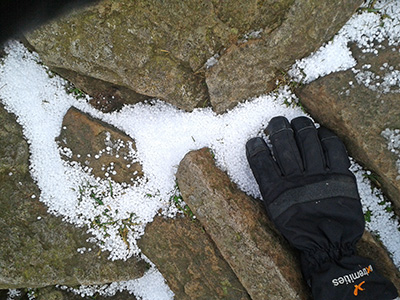Glossary
Dry snow metamorphism (or rounding)– loss of feathering, happens if not freeze thaw in strong temperature gradients i.e. sub zero air temperature. Can lead to point release up to 3 days after snowfall.
Depth Hoar / Facets This forms when there is a strong temperature gradient especially on un-consolidated snow (the temperature is usually around 0 degrees at the ground so if it is very cold in the air (-15 degrees say) on a shallow snow pack (50 cm) there is a big temperature gradient. It looks like glass gem stones (or dust or sugar). The smaller the facet the safer it is as they won't roll so well. Facets as big as 3mm across are a serious danger Depth Hoar is rare in Scotland as a large temperature flux means stable temperature gradient cannot establish. Also because much of the snow pack is deposited windslab, compact water migration does not occur so easily through it. However a barrier to migration can cause a layer to form. Facets are sometimes found round rocks.
 Graupel – Snow with Rime around it. If buried resistant to metamorphism can exist for weeks in the snowpack but can be stabilised by a major melt-freeze. What most people call hail is actually graupel, they look like polystyrene pellets from those big bean bags you got in the 1980's. They tend to fall apart when handled and are often called soft snow.
Graupel – Snow with Rime around it. If buried resistant to metamorphism can exist for weeks in the snowpack but can be stabilised by a major melt-freeze. What most people call hail is actually graupel, they look like polystyrene pellets from those big bean bags you got in the 1980's. They tend to fall apart when handled and are often called soft snow.
Leeward Slope - The Leeward (or Lee) slope is the side of the mountain that is sheltered from the wind. Snow is usually deposited here when blown from the windward slope
Melt - Freeze metamorphism. As you would guess this is where the layer melts a bit and then refreezes. During the melt phase the snow doesn't just melt but each crystal gets surrounded by water which then freezes during the freeze phase creating a strong bond with the crystal next to it and a stable layer. It isn't all good news though as there is a risk of a potentially devastating wet snow avalanche during the melt phase.
Surface hoar - Feathery surface ice (basically frozen dew) that if buried causes a weak layer. Destroyed very quickly by sun and wind so northerly aspects more at risk.
Windslab - Layer of broken Crystals – looks chalky and un-reflective.
- Formed if it is blowing over 20 mph while snowing or if snow has been moved.
- The faster the wind the more snow it holds so windslab forms when wind slows and dumps snow (on lea slopes)
- Can be stabilised by both dry snow metamorphism and melt freeze.
- Windslab accumulation of greater than 5cm / hour is of concern.
- Windslab that is new and rapidly deposited is particularly unstable.
Windward Slope - The side of the hill that is facing the (prevailing) wind. Windward slopes are usually scoured of snow as it is blow up the hill and deposited on the Lee Slope
